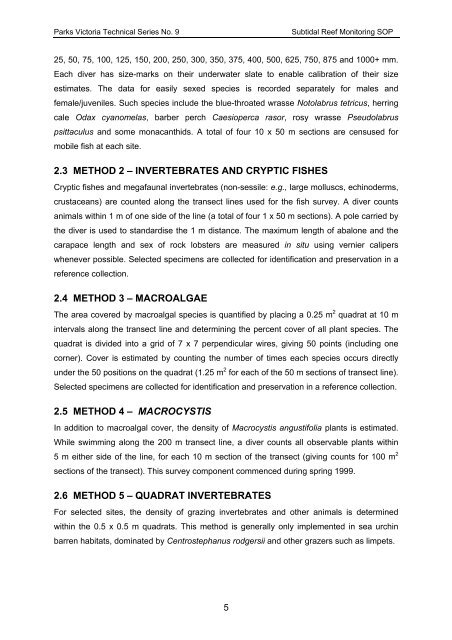Parks Victoria Standard Operating Procedure
Parks Victoria Standard Operating Procedure
Parks Victoria Standard Operating Procedure
- No tags were found...
You also want an ePaper? Increase the reach of your titles
YUMPU automatically turns print PDFs into web optimized ePapers that Google loves.
<strong>Parks</strong> <strong>Victoria</strong> Technical Series No. 9Subtidal Reef Monitoring SOP25, 50, 75, 100, 125, 150, 200, 250, 300, 350, 375, 400, 500, 625, 750, 875 and 1000+ mm.Each diver has size-marks on their underwater slate to enable calibration of their sizeestimates. The data for easily sexed species is recorded separately for males andfemale/juveniles. Such species include the blue-throated wrasse Notolabrus tetricus, herringcale Odax cyanomelas, barber perch Caesioperca rasor, rosy wrasse Pseudolabruspsittaculus and some monacanthids. A total of four 10 x 50 m sections are censused formobile fish at each site.2.3 METHOD 2 – INVERTEBRATES AND CRYPTIC FISHESCryptic fishes and megafaunal invertebrates (non-sessile: e.g., large molluscs, echinoderms,crustaceans) are counted along the transect lines used for the fish survey. A diver countsanimals within 1 m of one side of the line (a total of four 1 x 50 m sections). A pole carried bythe diver is used to standardise the 1 m distance. The maximum length of abalone and thecarapace length and sex of rock lobsters are measured in situ using vernier caliperswhenever possible. Selected specimens are collected for identification and preservation in areference collection.2.4 METHOD 3 – MACROALGAEThe area covered by macroalgal species is quantified by placing a 0.25 m 2 quadrat at 10 mintervals along the transect line and determining the percent cover of all plant species. Thequadrat is divided into a grid of 7 x 7 perpendicular wires, giving 50 points (including onecorner). Cover is estimated by counting the number of times each species occurs directlyunder the 50 positions on the quadrat (1.25 m 2 for each of the 50 m sections of transect line).Selected specimens are collected for identification and preservation in a reference collection.2.5 METHOD 4 – MACROCYSTISIn addition to macroalgal cover, the density of Macrocystis angustifolia plants is estimated.While swimming along the 200 m transect line, a diver counts all observable plants within5 m either side of the line, for each 10 m section of the transect (giving counts for 100 m 2sections of the transect). This survey component commenced during spring 1999.2.6 METHOD 5 – QUADRAT INVERTEBRATESFor selected sites, the density of grazing invertebrates and other animals is determinedwithin the 0.5 x 0.5 m quadrats. This method is generally only implemented in sea urchinbarren habitats, dominated by Centrostephanus rodgersii and other grazers such as limpets.5

















